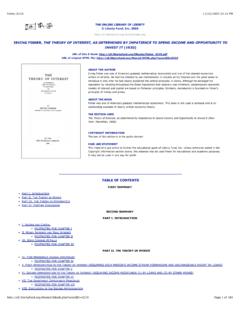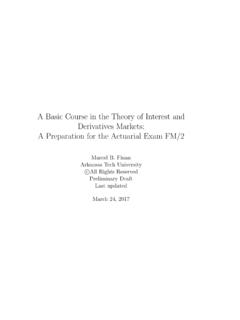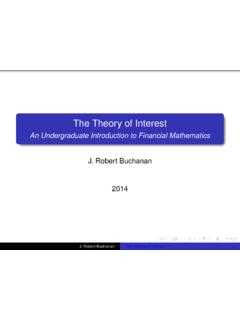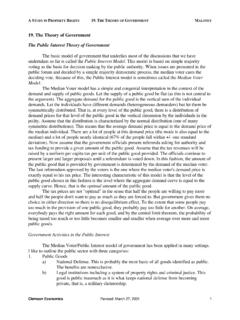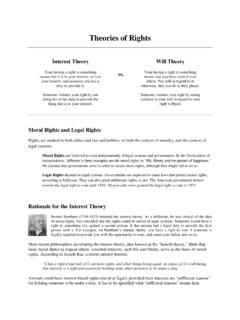Transcription of A Study of Motivation: How to Get Your Employees Moving
1 Page | 1 A Study of motivation : how to get your Employees Moving SPEA Honors Thesis Spring 2012 Indiana University Kelli Burton Management May 2012 Faculty Advisor: Cheryl Hughes May 2012 2 | Page Table of Contents Abstract .. 3 Personal Introduction .. 4 Topic Introduction .. 4 Research Methods .. 5 Definition of motivation .. 6 Theories of motivation .. 7 Maslow s Hierarchy of Needs .. 7 Herzberg s Two-Factor theory .. 9 The Four Motivations .. 11 PERMA Model .. 14 Example of motivation .. 15 Financial .. 16 Non-Financial .. 19 Implications for Managers .. 25 Conclusion .. 30 Resources .. 32 3 | Page Abstract Most employers today would like to have their employee s motivated and ready to work, but do not understand what truly motivates a person.
2 Companies could be more efficient if the Employees had an invested interest in the future of the company. There are essential needs to be met for a person, specifically an employee, to succeed in the workplace. I will examine different theories of motivations, how they are relevant to the workplace, and how employers can implement the theories to ensure happy and motivated Employees . The most important theories include: Maslow s hierarchy of needs, Herzberg s two-factor theory , Aristotle s seven causes, and the different types of motivation . Each theory is related in the fact that there are needs for all people to meet. Every employee is at a different stage in their lives, which requires different management techniques. It is shown that motivation must come from within the employee.
3 The theories investigated will help describe how managers can influence their Employees to self motivate and produce the best work possible. There are two specific types of motivation : financial and non-financial. I will focus on ways the employers can motivate their Employees using financial means as well as non-financial recognitions. In this day in time, there is not always a plentiful amount of money to spend on motivation , so it is important to understand how managers can make their Employees feel important without breaking the bank. Both types need to be executed in a strategic way to provide the best results. Lastly, I will focus on how managers are able to implement these types of motivation into their specific work place. This will show how motivation is important to all industries, and how it can change and impact the amount sales a company performs.
4 Motivated Employees will in 4 | Page turn create a successful company. Personal Introduction Honor students in the School of Public and Environmental Affairs (SPEA) at Indiana University must complete a thesis in order to graduate with an honors degree. I am a SPEA honors student studying management and human resources and will graduate in May 2012. The thesis topics are chosen based on the student s interests and the professors are assigned in order to provide guidance throughout the process. Professor Hughes has given me the courage and wisdom to complete this paper. Professor Hughes is a human resources professional who graduated from Indiana Wesleyan University in 2002 with a MBA. She was the Vice President of organizational development for Greater Bloomington Chamber of Commerce and has been a Lecturer at Indiana University since 2009.
5 Her helpful insights have allowed me to better understand motivation in the workplace. My interest in management and human resources has led me to research motivation and how it can be implemented in the workplace. Workplaces are suffering with Employees who are unmotivated and overall work performance is failing. If managers where educated on how to motivate, their Employees would be happier and the company as a whole would benefit. This topic is relevant to all disciplines and has the potential to impact all different kinds of work from the highest career levels, to the entry level jobs. Topic Introduction One may ask why there is a need for managers to spend time on motivating their Employees , but the answer is to extend their existence. Employees make up an organization and if they do not have organizational commitment, then there is no incentive to excel at their jobs.
6 A 5 | Page 1988 Study showed that eighty-six percent of organizations struggled with attracting new Employees and fifty-eight percent of those organizations expressed challenges with regards to retaining current Employees ( Ramlall, 52). Although this Study is older, the information is still relevant today. Studies show that when ten professional Employees of an organization leave, that organization loses roughly one million dollars (Ramlall, 52). In addition to the financial loss, they also suffer the loss of knowledge and experience the individual(s) may have, which is one of the most valued employee assets. This cost could be avoided or lessened by motivating Employees by keeping them involved and committed to the organization. Two important reasons that Employees should be motivated are to achieve their own personal goals and the organizational goals (Shanks, 23).
7 In a Study done by the Society for Human Resource Management, they found that eighty-six percent of the people they surveyed were satisfied with their jobs (SHRM). This number could increase if the soon to be discussed techniques are implemented in the specific work sites. In a different Study by Career Vision, they found that thirty-three percent of Employees feel as though they have reached a dead end in their career ("Job Satisfaction Statistics"). T he research presented will discuss the research and theories of motivation , then prove there is a need for motivation in all workplaces and explain the most effective ways of motivating Employees with financial and non-financial means. The final question is: how and in what ways can managers motivate their Employees to make them more productive to the organization?
8 Research Methods I began my research by interviewing people in the field of human resources to assist me in developing a clear understanding and focus of motivation . The topic from the beginning was motivation , but after talking to peers, adults, and my advisor I knew that I needed to focus on the 6 | Page why and how aspects of the topic. I began my research on the internet by using Google to get an understanding of exactly what I would be discussing. I then used search engines listed on the Indiana University library s website. Soon after, I decided to look through relevant books for information pertaining to motivation . Through all of these resources, I was able to gather the information needed in order to justify my argument. Definition of motivation Just like any other word, there are variations of definitions to describe a concept.
9 motivation too has many different definitions, but it is important to focus on those that are related to the workplace. Understanding exactly what motivation is will help managers decide what actions to take to encourage their Employees . The definition of motivation starts with the root word, motive. Webster s Dictionary defines motive as, something that causes a person to act. Therefore, motivation can be defined as, the act of providing motive that causes someone to act (Shanks, 24). In other words, according to Nancy Shanks, motivation causes someone to act and someone else cannot make someone motivated. It is the discretion of the person to decide if they are going to be motivated or not. Motivated and unmotivated are not opposites, but instead, there are determining factors that could cause someone to be unmotivated, such as life events and attitudes towards a specific job.
10 With relation to the workplace, Ray Williams, who writes for Psychology Today, defines motivation as, predisposition to behave in a purposeful manner to achieve specific, unmet needs and the will to achieve, and the inner force that drives individuals to accomplish personal organizational goals (Williams). A person becomes motivated in order to achieve their own personal goals as well as the organizational goals. The more motivated an employee is, the more likely they are to have organizational commitment and identify themselves with the organization. 7 | Page This will meet some of the unmet needs, and connect them with the organization. If willing, the manager is able to give the employee incentives to meet their own goals and the goals set by the organization.
